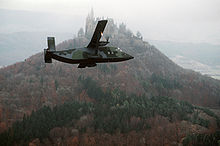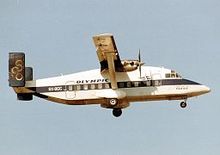Short 330
| Short 330 | |
|---|---|
 Short 330 from Loganair |
|
| Type: | Airliner , transport aircraft |
| Design country: | |
| Manufacturer: | |
| First flight: |
22nd August 1974 |
| Production time: |
until 1997 |
| Number of pieces: |
179 |
The Short 330 (also Shorts 330 ) is a short-haul passenger and cargo aircraft from the former British aircraft manufacturer Short Brothers .
history
Because the Short Skyvan's low performance potential limited sales, Shorts developed an improved, larger version called the SD3-30, which was later changed to Short 330.
The Short 330 has a wingspan that is 2.97 m larger than the Skyvan , a 3.78 m longer fuselage and space for up to 30 passengers. The variable cabin enabled a mixed passenger-freight operation adapted to requirements. What is very unusual is the fact that the captain and first officer can access their respective seats through two separate cockpit doors (on the right and left outside of the cabin). Like the Skyvan, the Short 330 does not have a pressurized cabin .
Two Pratt & Whitney PT6A-25B propeller turbines, each with a rated output of 862 k W (1,172 hp ) and a continuous output of 761 kW (1,035 hp), were selected as the drive .
Two prototypes were built , the first of which took off on its maiden flight on August 22, 1974 . Deliveries began almost two years later. Despite the initial lull, sales increased in the early 1980s. Interest in this pattern subsided in 1981 when production of the Short 360 began. In Germany, six machines of the DLT model were used, where they quickly received the nickname “shoe box”.
In 1982 two variants of the 330 appeared - the 330UTT (Utility Tactical Transport) and the Sherpa.
The UTT is a multi-purpose transport aircraft whose reinforced cabin floor could carry an increased payload of up to 3,630 kg. In addition, lashing fittings for securing the load were installed and the individual passenger doors were replaced by two inward-opening doors, so that the entry and exit of up to 30 paratroopers is easier and faster. A medical kit is also available for transporting up to 15 lying wounded. Only two copies of the UTT were sold in 1983 - one each to the Royal Thai Police and the Army . In 1984 a reorder for two machines followed and in 1985 another UTT went to Amiri Guard Air Wing .

The Sherpa was designed for the military transport of material and people. What makes it a powerful cargo aircraft is its cargo flap with a loading ramp in the rear. Four LD3 containers or seven C08 containers or two half- ton trucks (e.g. Land Rover) can be accommodated in the cargo hold . Thanks to the built-in seat rails, it is possible to quickly change between freight and passenger operations. In 1983 USAFE was looking for a versatile aircraft type for the European Distribution System (EDS) concept and decided on the Sherpa, 18 of which were ordered as C-23A in 1984. In order to manage the supply of the US missile test facility on the Kwajalein -Atoll, the US Army rented six machines from regional airlines .
In 1988 the US Army National Guard bought ten Sherpas to replace their De Havilland Canada C-7 Caribou . In 1992 the army ordered ten C-23Bs. In 1993 only three C-23A and C-23B were in service. From 2010, all C-23s will be retired and exchanged for Alenia C-27 vans .
By the end of production in mid-1997, a total of 179 Shorts 330, UTTs and Sherpas had left the Short factory.
Versions
- 330-100 - base version (previously SD3-30)
- 330-200 - larger tank capacity for greater range (previously 360 Advanced)
- 330-220 - light transport version
- 330-UTT - Utility Tactical Transport (Utility Tactical Transport), strengthened ground, structural reinforcement
- C-23A Sherpa - USAF version of the 330-UTT, two cabin windows on each side
- C-23B Sherpa - Version of the 330-UTT for the US Army National Guard, eleven cabin windows on each side
- JC-23A Sherpa - C-23A converted by the US Army for "electronic warfare"
Military users
-
 Brazil
Brazil
- Exército Brasileiro : 8 C-23B + (from US Army stocks, ordered in 2018)
-
 Djibouti
Djibouti
- Air Force / Force Aérienne du Djibouti : 2 C-23B (from US Army stocks)
-
 Philippines
Philippines
- Army: 2 C-23B + (from US Army stocks)
- Coast Guard: 2 C-23B + (from US Army stocks)
-
 Tanzania
Tanzania
-
 Thailand
Thailand
-
 United Arab Emirates
United Arab Emirates
-
 United States
United States
- US Air Force : 18 C-23A, stationed in Zweibrücken from 1985 to 1990
- US Army : 43 , 15 C-23B, 28 C-23B +
- United States Forest Service
- NASA
-
 Venezuela
Venezuela
Incidents
From the first flight in 1974 to March 2020, there were 23 total write-offs of aircraft with the Short 330. In 5 of them 41 people were killed. Selection:
- On October 28, 1983, shortly after taking off from Harrisburg International Airport , a passenger opened the rear door of a Short 330-200 of the Allegheny Commuter ( aircraft registration number N26288 ) and fell to the ground from a height of more than 1000 meters. The machine was able to return to the airport with the remaining 29 people on board (26 passengers and 3 crew members) (see also incident of the Allegheny Commuter at Middletown ) .
- On August 3, 1989, a Short 330-200 of Olympic Aviation (SX-BGE) was flown on the approach to Samos airport against the 1430 m high mountain Kerkis, 25 km away. The machine was flown according to visual flight rules , although the area around the airport was clouded. All 31 passengers and three crew members were killed in this controlled flight into terrain (CFIT).
- On 6 May 1993, the pilot 330-200 broke a Short of Atlantic Air BVI (VP-LVR) on the airport Beef Iceland ( British Virgin Islands from) the start, and the machine rolled into the sea on the end of the runway beyond. The aircraft was irreparably damaged, the 27 passengers and 3 crew members were uninjured. After all the instruments had been removed from the machine, it was sunk as a diving spot at a depth of 12 meters near Great Dog Island .
- On May 5, 2017, a Short 330-200 of the US cargo airline Air Cargo Carriers (N334AC) coming from Louisville had an accident while landing at Charleston-Yeager Airport ( West Virginia , USA). After a greatly shortened approach with an incline of up to 42 ° , the aircraft hit the left edge of the runway very hard, with the left wing breaking off and hurling it into uneven terrain. Above all, the captain, who was constantly assigned to the co-pilot, had already attracted attention several times due to deliberate deviations from and disregard of safety regulations as well as insufficient ability to fly blind. The two pilots, the only occupants, were killed. It was the fifth total loss of aircraft of the Shorts family at this airline, in which the complete lack of security programs was found.
Technical data (Short 330-220)
| Parameter | Data |
|---|---|
| crew | 2 |
| length | 17.69 m |
| span | 22.76 m |
| height | 4.95 m |
| Wing area | 42.08 m² |
| Wing extension | 12.3 |
| Empty mass | 6,680 kg |
| Max. Takeoff mass | 10,387 kg |
| Cruising speed | 351 km / h at an altitude of 3,050 m |
| Service ceiling | 3,500 m |
| Range | 875 km |
| drive | two propeller turbines Pratt & Whitney PT6A-45R , each 893 kW (1,198 PS) |
literature
- Types of aircraft in the world. Weltbild Verlag GmbH, Augsburg 1997, ISBN 3-86047-593-2 .
See also
Web links
Individual evidence
- ↑ picture on airliners.net
- ↑ US grants additional Sherpas to Brazil, Janes, June 19, 2018
- ↑ Accident Statistics Short 330 , Aviation Safety Network (English), accessed on April 1, 2020.
- ^ Accident report Short 330 SX-BGE , Aviation Safety Network (English) , accessed on November 5, 2015.
- ^ Accident report Short 330 VP-LVR , Aviation Safety Network (English), accessed on January 13, 2019.
- ↑ Flight International, October 8, 2019 (English), p. 13.
- ↑ accident report short 330 N334AC , Aviation Safety Network (English), accessed on April 1, 2020th


